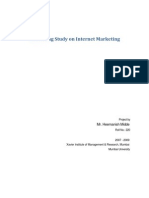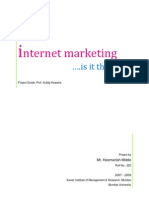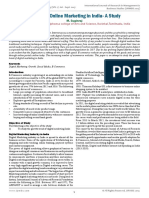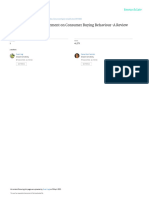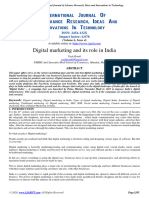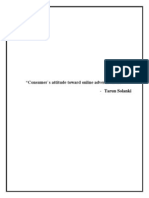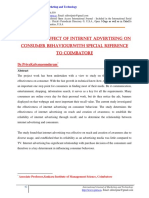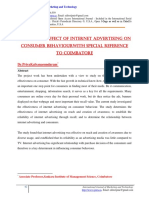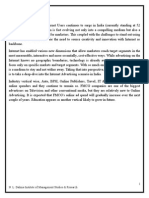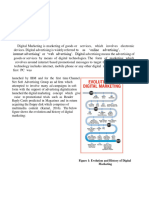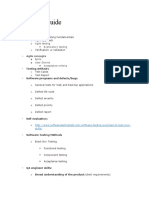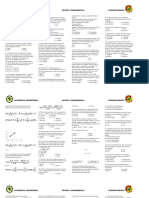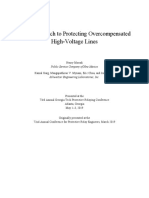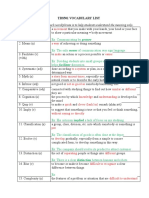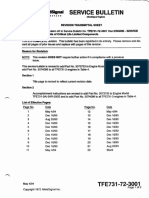A Study On Effectiveness of Internet Ad
Uploaded by
Siddhi kumariA Study On Effectiveness of Internet Ad
Uploaded by
Siddhi kumariInternational Journal of Engineering & Scientific Research
Vol.5 Issue 2, February 2017,
ISSN: 2347-6532 Impact Factor: 5.900
Journal Homepage: http://www.ijmra.us, Email: editorijmie@gmail.com
Double-Blind Peer Reviewed Refereed Open Access International Journal - Included in the International Serial
Directories Indexed & Listed at: Ulrich's Periodicals Directory ©, U.S.A., Open J-Gage as well as in Cabell’s
Directories of Publishing Opportunities, U.S.A
“A STUDY ON EFFECTIVENESS OF INTERNET
ADVERTISEMENTS ON STUDENTS BUYING
BEHAVIOUR IN THE COIMBATORE DISTRICT”
Dr.S.Franklin John*
Ms. R.Sheeja**
Ms.Bhavana P B***
Abstract:
The Internet enables consumers to access an unlimited range of products and services from vendors
around the world, and it has reduced the time and effort they spend on shopping. Consumers play a
much more active role in searching for information online with some goal in mind. The mind set will
influence individuals buying behaviours and responses to online information and advertisements.
With the rapid advancement in the virtual industry, many companies have made the Internet as part
of their advertising media mix to take advantage of the online space. The Internet has become a
popular advertising platform because marketers found that the Internet possess greater flexibility and
control over the advertising information. The rapid use of smart phones among the students is leads
to expose them towards the internet advertisements. The study has conducted among the students of
Arts & Science, Engineering, MBA and MCA students in the Coimbatore District. The objective of
this is to indemnity the influence of internet advertising on the students buying behaviour and also
measures the satisfaction level of the students compared to the previous purchases. This study will
thought some light on the growing space of internet revolution in the time of demonetisation.
Government of India is giving more promotion for digitisation of India. This study focus on the
present ―Z‖ generation and who are going to be the professionals of tomorrow.
Keywords: Internet Advertising, Students, Buying behaviour, Z Generation.
*
Professor& Principal, Nehru College of Management, Coimbatore
**
Assistant Professor, Nehru College of Management, Coimbatore
***
II MBAStudent, Nehru College of Management, Coimbatore
23 International Journal of Engineering and Scientific Research
http://www.ijmra.us, Email: editorijmie@gmail.com
ISSN: 2347-6532 Impact Factor: 5.900
Introduction
Internet has grown tremendously in both its applications and number of users due to its unique
characteristics of flexibility, interactivity, and personalization. It has been a very useful tool for
communication, entertainment, education, and electronic trade. The revolutionary change
brought forth by information technology has an important impact on the daily lives. It has
transformed the way we do business by allowing retailers to offer unlimited range of products
and services to all consumers from around the world at any point in time. The Internet has
emerged as an advertising medium. Many companies have turned to the Internet to advertise
their products and services; and the Internet is deemed to be the most significant direct marketing
channel for the global marketplace. Companies are pouring billions of dollars into Internet
advertising to obtain greater return on investment on ads. The Internet has given consumers more
control in accessing information on products and services. There are several factors that
contribute to consumers pull for online content—consumers are the one who decide when,
where, what, and how much commercial content they wish to view.
The Internet enables consumers to access an unlimited range of products and services from
companies around the world, and it has reduced the time and effort they spend on shopping.
Consumers play a much more active role in searching for information online with some goal in
mind, and that goal can influence individual behaviours and responses to online information and
advertisements. With the rapid advancement in the computer industry, many companies have
made the Internet as part of their advertising media mix to take advantage of the online
technologies. The Internet has become a popular advertising platform because marketers found
that the Internet possess greater flexibility and control over the advertising materials. Since the
Internet can be used as an efficient marketing communication tool, both scholars and
practitioners are interested in understanding how to take full advantage and maximizing the
value of this communication medium Consumers within Kenya have been largely exposed to the
traditional advertising forms as the main media used by advertisers to provide information.
However, over the years marketing strategies have evolved with technology leading to the
internet creating unprecedented opportunities for digital marketers to connect with customers to
create an immersive connected digital environment, influence and drive purchases, fuel new
growth and create new market share. The growth of internet advertising is both globally and
24 International Journal of Engineering and Scientific Research
http://www.ijmra.us, Email: editorijmie@gmail.com
ISSN: 2347-6532 Impact Factor: 5.900
locally outpacing offline advertising. While outdoor advertising is also experiencing growth, it is
not growing as rapidly as Internet advertising.
Internet Advertising in India
The Indian advertising industry has evolved from being a small-scaled business to a full-fledged
industry. The advertising industry is projected to be the second fastest growing advertising
market in Asia after China.
It is estimated that by 2018, the share of ad spend in India’s Gross Domestic Product (GDP) will
be around 0.45 per cent.
The Indian government has given tremendous support to the advertising and marketing industry.
Advertising expenditure is likely to increase in the financial sector, driven by Reserve Bank of
India (RBI) policies which could result in a more favourable business environment. Also,
proposed licences for new banks and better market sentiments render the advertising and
marketing industry in India a fertile space. India’s Advertising industry is expected to grow at a
rate of 16.8 per cent year-on-year to Rs 51,365 crore (US$ 7.61 billion) in 2016#, buoyed by
positive industry sentiment and a strong GDP growth of 7 per cent and above.
India's digital advertising market has grown at a fast pace of 33 per cent annually between 2010
and 2015, while spending as a percentage of total advertising increased to 13 per cent or nearly
US$ 1 billion in 2015. Print contributes a significant portion to the total advertising revenue,
accounting for almost 41.2 per cent, whereas TV contributes 38.2 per cent, and digital
contributes 11 per cent of the total revenue. Outdoor, Radio and Cinema make up the balance
10%.
25 International Journal of Engineering and Scientific Research
http://www.ijmra.us, Email: editorijmie@gmail.com
ISSN: 2347-6532 Impact Factor: 5.900
Of the current Rs 2,750 crore (US$ 407.66 million) digital advertisement market, search and
display contribute the most - search advertisements constitute 38 per cent of total advertisement
spends followed by display advertisement at 29 per cent, as per the study.
The Internet's share in total advertising revenue is anticipated to grow twofold from eight per
cent in 2013 to 16 per cent in 2018. Online advertising, which was estimated at Rs 2,900 crore
(US$ 429.9 million) in 2013, could jump threefold to Rs 10,000 crore (US$ 1.48 billion) in five
years, increasing at a compound annual rate of 28 per cent.
The country's digital advertising market is projected to grow at a CAGR of 35 per cent to reach
Rs 7,044 crore by the end of this year, an IAMAI-IMRB report said today.
The digital advertising market was pegged at Rs 5,200 crore at the end of December 2015,
accounting for about 12 per cent of the total advertisement spends in the country, the report titled
'Digital Advertising in India' said.
Majority business owners worldwide know that the Internet has now become an essential tool
when it comes to running their businesses successfully. However, you should also understand the
role played by the Internet in the lives of their customers. You should be capable to locate people
who are using the Internet; their key interests in the time spend on the Internet and their
preferences to purchase products and services on a daily basis.
Business owners now have got various ways and websites to advertise about their company and
offered products and services. Exchange media is a leading company that supports and
specialises in providing services related to Internet advertising. Exchange media is a single stop
information platform for Internet based advertising providing the latest news, views, analytical
information, and in depth analysis of events. For updated news about Internet advertising.
Generation ‘Z’
Generation Z also known as Post-Millennial, Founders, Plurals, or the Homeland Generation is
the demographic cohort after the Millennials. There are no precise dates for when the Gen Z
26 International Journal of Engineering and Scientific Research
http://www.ijmra.us, Email: editorijmie@gmail.com
ISSN: 2347-6532 Impact Factor: 5.900
cohort starts or ends; demographers and researchers typically use starting birth years that range
from the mid-1990s to early 2000s, and as yet there is little consensus about ending birth years.
A significant aspect of this generation is the widespread usage of the Internet from a young age.
Members of Generation Z are typically thought of as being comfortable with technology, and
interacting on social media websites for a significant portion of their socializing. Some
commentators have suggested that growing up through the Great Recession has given the cohort
a feeling of unsettlement and insecurity.
Generation Z is the first to have Internet technology so readily available at a very young
age. With the web revolution that occurred throughout the 1990s, they have been exposed to an
unprecedented amount of technology in their upbringing. As technology became more compact
and affordable, the popularity of smart phones in the United States grew exponentially. With
77% of 12–17 year olds owning a cell phone in 2015, technology has strongly influenced
Generation Z in terms of communication and education. Forbes magazine suggested that by the
time Generation Z entered the work place; digital technology would be an aspect of almost all
career paths. Anthony Turner characterizes Generation Z as having a 'digital bond to the
Internet', and argues that it may help youth to escape from emotional and mental struggles they
face offline. According to US consultants Sparks and Honey in 2014, 41% of Generation Z
spends more than three hours per day using computers for purposes other than schoolwork,
compared to 22% in 2004.
In 2015, Generation Z comprised the largest portion of the U.S. population, at nearly 26%,
edging out Millennials (24.5%), and the generation is estimated to generate $44 billion in annual
spending. About three-quarters of 13–17 years olds use their cell phones daily, more than they
watch TV. Over half of surveyed mothers say the demo influences them in purchasing decisions
for toys, apparel, dinner choices, entertainment, TV, mobile and computers. Among social
media, only Instagram is in popularity in the demo.
In 2015, an estimated 150,000 apps, 10% of those in Apple's App Store, were educational and
aimed at children up to college level. While researchers and parents agree the change in
educational paradigm is significant, the results of the changes are mixed. On one hand, smart
27 International Journal of Engineering and Scientific Research
http://www.ijmra.us, Email: editorijmie@gmail.com
ISSN: 2347-6532 Impact Factor: 5.900
phones offer the potential for deeper involvement in learning and more individualized
instruction, thereby making this generation potentially better educated and better-rounded. On
the other hand, some researchers and parents are concerned that the prevalence of smart phones
will cause technology dependence and a lack of self-regulation that will hinder child
development.
Teens are much more likely to share different types of information, as of 2012, compared to in
2006. However, they will take certain steps to protect certain information that they do not want
being shared. They are more likely to "follow" others on social media than "share" and use
different types of social media for different purposes. Focus group testing found that while teens
may be annoyed by many aspects of Face book, they continue to use it because participation is
important in terms of socializing with friends and peers. Twitter and Instagram are seen to be
gaining popularity in member of Generation Z, with 24% (and growing) of teens with access to
the Internet having Twitter accounts. This is, in part, due to parents not typically using these
social networking sites. Snap chat is also seen to have gained attraction in Generation Z because
videos, pictures, messages send much faster than regular messaging. Speed and reliability are
important factors in how members of Generation Z choice of social networking platform.
In a study performed by psychologists it was found that young people use the Internet as a way
to gain access to information and to interact with others. Mobile technology, social media, and
Internet usage have become increasingly important to modern adolescents over the past decade.
Very few, however, are changed from what they gain access to online. Youths are using the
Internet as a tool to gain social skills, that they then apply to real life situations, and learn about
things that interest them. Teens spend most of their time online in private communication with
people they interact with outside the Internet on a regular basis. While social media is used for
keeping up with global news and connections, it is mainly used for developing and maintaining
relationships with people with whom they are close in proximity. The use of social media has
become integrated into the daily lives of most Gen Z'ers who have access to mobile technology.
They use it on a daily basis to keep in contact with friends and family, particularly those who
they see every day. As a result, the increased use of mobile technology has caused Gen Z'ers to
spend more time on their smart phones, and social media and has caused online relationship
28 International Journal of Engineering and Scientific Research
http://www.ijmra.us, Email: editorijmie@gmail.com
ISSN: 2347-6532 Impact Factor: 5.900
development to become a new generational norm. Gen Z'ers are generally against the idea of
photo shopping and they are against changing themselves to be considered perfect. The parents
of the Gen Z'ers fear the overuse of the Internet by their children. Parents have a disliking for the
access to inappropriate information and images as well as social networking sites where children
can gain access to people from all over. Children reversely felt annoyed with their parents and
complained about parents being overly controlling when it came to their Internet usage. Gen Z
uses social media and other sites to strengthen bonds with friends and to develop new ones. They
interact with people, who they otherwise would not have met in the real world, becoming a tool
for identity creation.
The need for the study
The study is focussed on the influence of internet advertising on the students belongs to Z
generation in the Coimbatore city. The study focus on what kind of marketing tactics will be
effective towards the community. Habitualization of social media of this generation created more
use of facebook, whatsapp, etc. This study helps the marketer to identify the different ways to
use social media to advertise their products since this generation seeks suggestions and
guidelines from their peers through these social media. This study also focus on finding factors
affecting the student’s buying behaviour through internet advertising.
Limitations of the Study
The study covered only the students of Arts & Science, engineering, MBA and MCA students of
Coimbatore, Tamilnadu. So the results cannot be generalized for the other states of India. Due to
lack of time we were unable to cover a larger sample.
Objectives
To study the influence of internet advertising on students purchase decision making
To identify the suitable internet advertising for the Z generation.
Methodology
29 International Journal of Engineering and Scientific Research
http://www.ijmra.us, Email: editorijmie@gmail.com
ISSN: 2347-6532 Impact Factor: 5.900
The structured questionnaire was developed after a detailed discussion with both academia and
industries from Coimbatore. Stratified random sampling method is used for the study and the
stratum is created based on the degree which the students are studying. From each stratum 25
students were selected randomly, altogether 100 samples were collected. The collected data was
analyzed using percentage analysis.
Analysis and Interpretation
Table1: Time spend on Internet by the respondent
Particulars Frequency Percent Valid Percent Cumulative Percent
Vali less than
19 19.0 19.0 19.0
d 1hr
1-2hrs 22 22.0 22.0 41.0
2-4hrs 26 26.0 26.0 67.0
more than
33 33.0 33.0 100.0
4hrs
Total 100 100.0 100.0
Source: Primary data
Chart 1: Time spend on Internet by the respondent
Inference: Table reveals that 33% of the respondents are using internet for more than 4 hours a
day, 26% use 2 to 4 hours per day and 22% use 1 to 2 hours and rest 19% use less than one hour
in a day.
Table 2: Mode of advertisements influences the respondent
Particulars Minimum Maximum Mean Std. Deviation
Online Advertisements 1 5 2.55 1.690
News Paper, Magazines 1 5 2.86 1.128
30 International Journal of Engineering and Scientific Research
http://www.ijmra.us, Email: editorijmie@gmail.com
ISSN: 2347-6532 Impact Factor: 5.900
Social media –Blogs,Forums,
1 5 2.96 1.188
Social Networking Sites
TV Commercial 1 5 2.97 1.439
Friends &
1 5 3.62 1.339
Relatives(Recommendation)
Valid N (listwise)
Source: Primary data
Inference
The above table reveals that most of the respondent ranked no.1 recommendation by the friends
and relatives as the mode of advertisement influences them the most. 2nd rank comes the TV
commercials, 3rd rank goes to social media blogs, 4th rank for newspaper magazines and 5th rank
for online advertisements.
Table 3: Use of Internet by the respondent
Freque Valid Cumulative
ncy Percent Percent Percent
Valid Yes 79 79.0 79.0 79.0
No 21 21.0 21.0 100.0
Total 100 100.0 100.0
Source: Primary data
Inference
The above table reveals that 79% of the respondents are regularly using internet. Remaining 21%
respondents are not regular internet users.
31 International Journal of Engineering and Scientific Research
http://www.ijmra.us, Email: editorijmie@gmail.com
ISSN: 2347-6532 Impact Factor: 5.900
Table 4: Viewing of advertisement while opening a web page by the respondent
Valid
Frequency Percent Percent Cumulative Percent
Valid Yes 84 84.0 84.0 84.0
No 16 16.0 16.0 100.0
Total 100 100.0 100.0
Source: Primary data
Inference
The above table reveals that 84% of the respondents were seen an advertisement while opening a
web page and remaining 16% marked them didn’t see any advertisement while opening a web
page.
Table 5: Purpose for which Internet is used by the respondent
Particulars Minimum Maximum Mean Std. Deviation
Entertainment 1 5 3.25 1.424
Social Networking 1 5 3.21 1.258
Information 1 5 3.03 1.210
Official Purpose 1 5 2.91 1.401
E-Commerce 1 5 2.57 1.635
Valid N (listwise)
Source: Primary data
Inference
The above table shows that most of the respondent ranked 1 for entertainment, 2 for social
networking, 3 for Information, 4 for Official purpose and 5 for E-commerce.
32 International Journal of Engineering and Scientific Research
http://www.ijmra.us, Email: editorijmie@gmail.com
ISSN: 2347-6532 Impact Factor: 5.900
Table 6: Viewing of advertisement while opening a web page by the respondent
Frequency Percent Valid Percent Cumulative Percent
Valid Yes 84 84.0 84.0 84.0
No 16 16.0 16.0 100.0
Total 100 100.0 100.0
Source: Primary data
Inference
The above table reveals that 84% of the respondents were seen an advertisement while opening a
web page and remaining 16% marked them didn’t see any advertisement while opening a web
page.
Table 7: Respondents made purchase after seeing online advertisements
Frequency Percent Valid Percent Cumulative Percent
Valid Yes 71 71.0 71.0 71.0
No 29 29.0 29.0 100.0
Total 100 100.0 100.0
Source: Primary data
Inference
The table shows that 71% of the respondents made purchase after seeing an online
advertisement. The remaining 29% noted that they didn’t made any purchase after seeing online
advertisements.
Table 8: The kind of internet advertisement most influenced the respondent
Minimum Maximum Mean Std. Deviation
Others 1 5 3.78 1.779
Display Advertisements 1 5 3.00 .921
33 International Journal of Engineering and Scientific Research
http://www.ijmra.us, Email: editorijmie@gmail.com
ISSN: 2347-6532 Impact Factor: 5.900
Google Ad-Word(Pay per
1 5 2.94 1.118
Click)
Social Media
1 5 2.84 1.516
Advertisements
Banner Advertisements 1 5 2.40 1.206
Valid N (listwise)
Source: Primary data
Inference
The above table shows that the banner advertisements ranked 1 as the most influenced type of
internet advertisements by the respondent. Social media advertisement ranked 2, Google ad-word
ranked 3 and display advertisements and other type of internet advertisement ranked 5 and 6
respectively.
Table 9: Perception on the Internet Advertisement
Valid Cumulative
Frequency Percent Percent Percent
Valid Informative 59 59.0 59.0 59.0
Annoying 27 27.0 27.0 86.0
create awareness 6 6.0 6.0 92.0
Entertaining 8 8.0 8.0 100.0
Total 100 100.0 100.0
Source: Primary data
Inference
The above table reveals that 59% of the respondents perceived the advertisements as
Informative, 27% respondents perceived as annoying, 8% as entertaining and 6% perceived
internet advertising as it create awareness.
34 International Journal of Engineering and Scientific Research
http://www.ijmra.us, Email: editorijmie@gmail.com
ISSN: 2347-6532 Impact Factor: 5.900
Table 10: Preference of online purchase
Frequency Percent Valid Percent Cumulative Percent
Valid Yes 84 84.0 84.0 84.0
No 16 16.0 16.0 100.0
Total 100 100.0 100.0
Source: Primary data
Inference
The above table reveals that 84% of the respondent willing to prefer online purchase again. 16%
of the respondents noted that they don’t prefer online purchase anymore.
Table 11: Factors for prefer online purchase
Minimum Maximum Mean Std. Deviation
Easiness 1 5 3.39 1.563
Convenience 1 5 3.16 1.098
Speed of Delivery 1 5 2.92 1.245
Lower Price 1 5 2.78 1.626
Product Quality 1 5 2.76 1.408
Valid N (list wise)
Source: Primary data
Inference
The above table reveals that Product quality is at no.1 factor to prefer online shopping by the
respondent. Lower price of the product noted second rank by the respondents. Speed of delivery,
convenience, and easiness comes to 3rd, 4th, and 5th rank respectively.
Interpretation and Discussion
From the above analysis and interpretations and the help of the literature review, we form the
following discussions to understand why this results has occurred.
35 International Journal of Engineering and Scientific Research
http://www.ijmra.us, Email: editorijmie@gmail.com
ISSN: 2347-6532 Impact Factor: 5.900
Friends and relatives play a vital role and major mode of the influencing factors which
influence the purchase of a product or services. 2nd rank comes to the TV commercials, 3rd rank
goes to social media blogs, 4th rank for newspaper magazines and 5th rank for online
advertisements.
Social networking and entertainment are the two major factors which motivates the
students to use internet than any other reasons like news, business, etc,.
The banner advertisements ranked 1 as the most influenced type of internet
advertisements by the students. Social media advertisement ranked 2, Google ad-word ranked 3
and display advertisements and other type of internet advertisement ranked 5 and 6 respectively.
Product quality is the number one criteria for the preference of online shopping by the
students. Lower price of the product, Speed of delivery, convenience, and easiness are the other
criteria for the online shopping.
Majority of the respondents used to click and look into the ads while opening a web page
since it is attractive. They used to consider the internet ad as an informative one and they use
internet ad as a good source of information on products and services.
Conclusion
The study concludes that internet advertising influenced purchase decision of the students to a
large extent the half of the respondents were influenced purchase decision. However, internet
advertising is a key determinant of purchase decision of the students as they consider it to be an
interaction point between them and the company from which they buy their products from.
Facebook and whats app are famous app among this Z generation so if the marketer use these
apps in an effective way to market the products and services. Participative ads and the ads which
make the students to understand about the ad with a short time is most preferred. In addition,
there is a positive relationship between consumer behaviour and internet advertising. This
implies that companies should invest more in internet advertising to increase their market share
and conduct a market research on the different markets in various countries to ensure that the
internet advertising initiatives being implemented suits the targeted markets to improve product
purchases.
36 International Journal of Engineering and Scientific Research
http://www.ijmra.us, Email: editorijmie@gmail.com
ISSN: 2347-6532 Impact Factor: 5.900
References:
Impact of online advertising on consumer Attitudes and interests buy online (Survey On
Students Of Internet Users In Makassar) Internatinal Journal of Scientific & Technology
Research volume 4, issue 04, april 2015.
Online advertising and its impact on consumer buying behaviour. IJRFM Volume 3,
Issue 1 (February 2013) (ISSN 2231-5985).
Effective advertising and its influence on consumer buying behaviour. European Journal
of Business and Management. www.iiste.org ISSN 2222-1905 (Paper) ISSN 2222-2839 (Online)
Vol 3, No.3.
Influence of web advertising on consumer behaviour in Maiduguri Metropolis,
Nigeria.Asian Journal Of Social Sciences & Humanities.
E-commerce: It’s Impact on consumer Behavior. Global Journal of Management and
Business Studies.ISSN 2248-9878 Volume 3, Number 2 (2013), pp. 131-138© Research India
Publications http://www.ripublication.com/gjmbs.htm.
An Empirical Study of Email-Based Advertisement and its Influence on Consumers’
Attitude. International Review of Management and Marketing Vol. 2, No. 3, 2012, pp.130-138
ISSN: 2146-4405 www.econjournals.com. No.1, 2013.
A study on impact of online advertising on consumer behavior (with special reference to
e-mails). International journal of Engineering and Management Sciences.VOL.3 (4) 2012: 461-
465 ISSN 2229-600 X.
Identifying Potentiality Online Sales In Malaysia: A Study On Customer Relationships
Online Shopping. Journal of Applied Business Research – Fourth Quarter 2006 Volume 22,
Number 4.
Marketing in Hypermedia Computer-Mediated Environments:Conceptual Foundations.
Journal of Marketing, 60 (July), 50-68.
Generation Z as Consumers: Trends and Innovation Stacy Wood Langdon Distinguished
Professor of Marketing, College of Management, N.C. State University.
How Generations Think: Research on Generation Z Mária Törőcsik PhD, University
Professor, University of Pécs, Faculty of Business and Economics, Pécs torocsik@ktk.pte.hu
Krisztián Szűcs PhD, Senior Lecturer, University of Pécs, Faculty of Business and Economics,
Pécs szucsk@ktk.pte.hu Dániel Kehl PhD, Senior Lecturer, University of Pécs, Faculty of
37 International Journal of Engineering and Scientific Research
http://www.ijmra.us, Email: editorijmie@gmail.com
ISSN: 2347-6532 Impact Factor: 5.900
Business and Economics, Pécs kehld@ktk.pte.hu. Acta Universitatis Sapientiae, Communicatio,
1 (2014) 23–45.
Meet Generation Z: The second generation within the giant "Millennial" cohort By Bruce
Tulgan and RainmakerThinking, Inc.
Marketing to the Generations Kaylene C. Williams California State University, Stanislaus
Robert A. Page Southern Connecticut State University. Journal of Behavioral Studies in
Business.
The Use Of Internet Resources By University Students During Their Course Projects
Elicitation: A Case Study Yasar Guneri SAHIN Izmir University of Economics Department of
Software Engineering Balcova / Izmir – Turkey yasar.sahin@ieu.edu.tr Sabah BALTA Yasar
University Department of Tourism Management Bornova / Izmir – Turkey
sabah.balta@yasar.edu.tr Tuncay ERCAN Yasar University Department of Computer
Engineering Bornova / Izmir – Turkey tuncay.ercan@yasar.edu.tr. TOJET: The Turkish Online
Journal of Educational Technology – April 2010, volume 9 Issue 2.
The Influence of Internet Usage on Academic Performance and Face-to-Face
Communication Sushma Bagavadi Ellore1 , Suman Niranjan2 and Ulysses J. Brown, III3.
Journal of Psychology and Behavioral Science June 2014, Vol. 2, No. 2, pp. 163-186 ISSN:
2374-2380 (Print) 2374-2399.
Impact Of Information Technology (It) On Consumer Purchase Behavior Dr. Mahabir
Narwal Associate Professor Department of Commerce, Kurukshetra University, Kurukshetra,
India. Dr. Geeta Sachdeva Assistant Professor Beehive College of Management & Technology
Dehradun, India. Researchers World -Journal of Arts, Science & Commerce ■ E-ISSN 2229-
4686 ■ ISSN 2231-4172.
Facebook influence on university students' media habits: qualitative results from a field
research Nicola Cavalli, Elisabetta Ida Costa, Paolo Ferri, Andrea Mangiatordi, Marina Micheli,
Andrea Pozzali, Francesca Scenini and Fabio Serenelli.
Influence of Parents, Peers, Internet Product Search and Visual Social Media on College
Students ’ Purchase Behavior: A Mixed Methods Study Jennifer E. Johnson University of
Nebraska-Lincoln, jennybeth.johnson@huskers.unl.edu.
38 International Journal of Engineering and Scientific Research
http://www.ijmra.us, Email: editorijmie@gmail.com
ISSN: 2347-6532 Impact Factor: 5.900
Online Shopping Attitude Among The Youth: A Study On University Students Deepjyoti
Choudhury And Abhijit Dey. International Journal of Entrepreneurship and Development
Studies (IJEDS) 2(1) 2014, 23-32.
39 International Journal of Engineering and Scientific Research
http://www.ijmra.us, Email: editorijmie@gmail.com
You might also like
- 15 A Review Paper On Digital AdvertisingNo ratings yet15 A Review Paper On Digital Advertising4 pages
- Growth of Online Marketing in India-A StudyNo ratings yetGrowth of Online Marketing in India-A Study6 pages
- Emergence of Internet Marketing: Dinesh .S. MudaliarNo ratings yetEmergence of Internet Marketing: Dinesh .S. Mudaliar72 pages
- Digital Marketing Project (1) - Removed - Removed (2) (2) - 01No ratings yetDigital Marketing Project (1) - Removed - Removed (2) (2) - 0175 pages
- Indusyprofile: Digital Marketing Industry in IndiaNo ratings yetIndusyprofile: Digital Marketing Industry in India12 pages
- Internet Marketing: The New Era of Innovation in E-CommerceNo ratings yetInternet Marketing: The New Era of Innovation in E-Commerce6 pages
- SMU MBA Final Project Vijay Sood 1302017393 LibreNo ratings yetSMU MBA Final Project Vijay Sood 1302017393 Libre61 pages
- E-Marketing Is Growing Faster Than Other Types of MediaNo ratings yetE-Marketing Is Growing Faster Than Other Types of Media86 pages
- Indian Scenario and Digital Marketing: Mehta Vishal and Tare UnmekhaNo ratings yetIndian Scenario and Digital Marketing: Mehta Vishal and Tare Unmekha6 pages
- Digital Marketing and Its Role in IndiaNo ratings yetDigital Marketing and Its Role in India10 pages
- A Study On Impact of Online Advertising On Consumer Behavior (With Special Reference To E-Mails)No ratings yetA Study On Impact of Online Advertising On Consumer Behavior (With Special Reference To E-Mails)5 pages
- A Descriptive Study of The Effectiveness of Internet Advertising On Consumer Buying Behavior in Nagpur CityNo ratings yetA Descriptive Study of The Effectiveness of Internet Advertising On Consumer Buying Behavior in Nagpur City12 pages
- Consumer Perception Towards Online Advertisments: A Final Project Report OnNo ratings yetConsumer Perception Towards Online Advertisments: A Final Project Report On9 pages
- A Study On Effect of Internet Advertising On Consumer Behaviourwith Special Reference To CoimbatoreNo ratings yetA Study On Effect of Internet Advertising On Consumer Behaviourwith Special Reference To Coimbatore8 pages
- Impact of Digital Marketing On Consumer Buying BehaviourNo ratings yetImpact of Digital Marketing On Consumer Buying Behaviour8 pages
- Internet Marketing Is Any Means You Use To Market Your Business OnlineNo ratings yetInternet Marketing Is Any Means You Use To Market Your Business Online7 pages
- School As Learning Organisation: The Role of Principal's Transformational Leadership in Promoting Teacher EngagementNo ratings yetSchool As Learning Organisation: The Role of Principal's Transformational Leadership in Promoting Teacher Engagement6 pages
- Mechanical Engineering Review 2 Fundamentals ThermodynamicsNo ratings yetMechanical Engineering Review 2 Fundamentals Thermodynamics5 pages
- Certificate of Test and Thorough Examination of Mobile CraneNo ratings yetCertificate of Test and Thorough Examination of Mobile Crane2 pages
- PNM Approach To Protecting Overcompensated High-Voltage LinesNo ratings yetPNM Approach To Protecting Overcompensated High-Voltage Lines13 pages
- Automotive Service Management: Principles Into Practice33% (3)Automotive Service Management: Principles Into Practice14 pages
- Unfolding Meaning From Memories: An Integrative Meaning Reconstruction Method For Counseling The BereavedNo ratings yetUnfolding Meaning From Memories: An Integrative Meaning Reconstruction Method For Counseling The Bereaved17 pages
- Prototype Approach To Semantic StructureNo ratings yetPrototype Approach To Semantic Structure34 pages
- 25x26 House Plan From House Construction Telegu YouTube ChannelNo ratings yet25x26 House Plan From House Construction Telegu YouTube Channel1 page
- Deloitte Uk Deloitte Financial Advisory Global Brand Guidelines and Toolkit PDF100% (1)Deloitte Uk Deloitte Financial Advisory Global Brand Guidelines and Toolkit PDF73 pages




